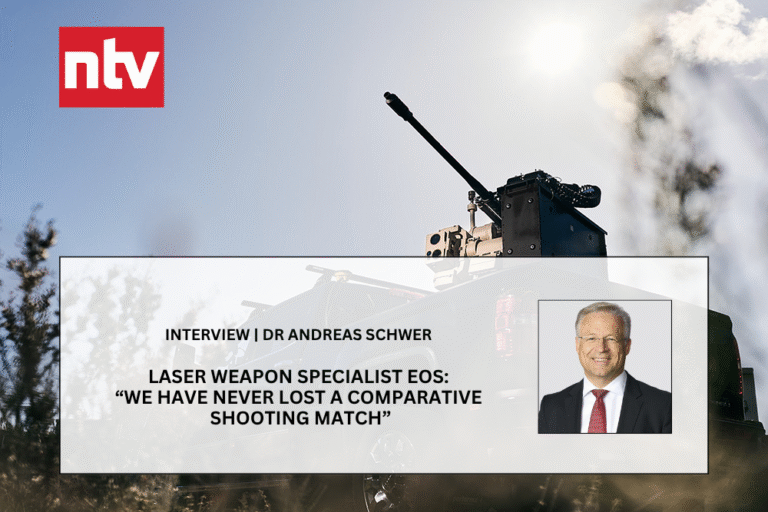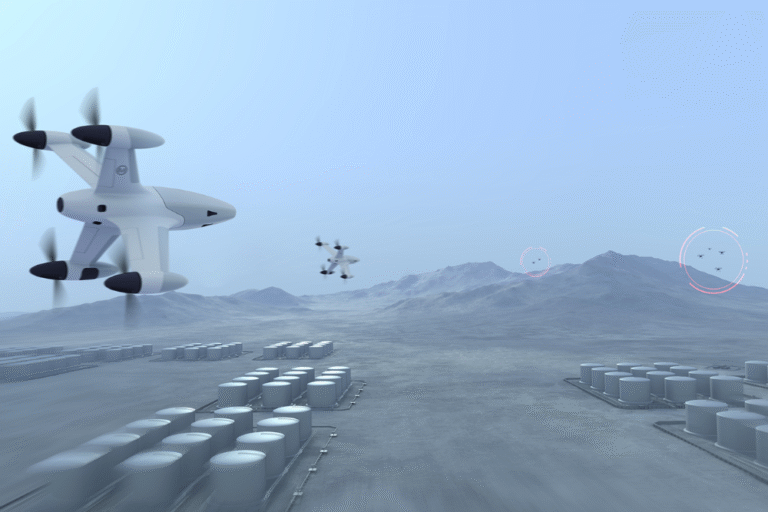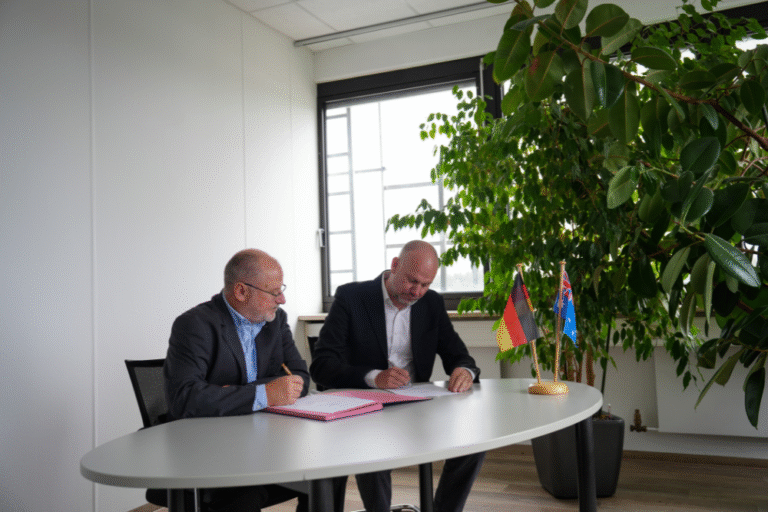

28 August 2025
CEO of EOS, Andreas Schwer, in conversation with APDR editor Kym Bergmann
In a wide-ranging interview with APDR, EOS CEO Dr Andreas Schwer discusses how EOS is setting the pace in counter-drone defence, high-energy lasers and space control. He outlines how shifting customer needs are driving demand and why EOS’ portfolio is positioned to deliver decisive advantage.
Kym: It’s a while since we have chatted, so could you please start with an overall summary of EOS?
Andreas: After a successful restructuring, we have started our new strategy which is built on three pillars. One pillar is our classical remote weapon station business, which has experienced significant growth. We continue to see opportunities in the counter-UAS business – the counter-drone field – where our system has been baselined by many NATO countries to the effector of choice against Class One and Class Two drones.
Pillar Two is our high energy laser business that is now coming to fruition. It is payback time after many years of inhouse investment – and we have just signed our first contract for a 100 kilowatt laser. This is a gamechanger for EOS and also for the entire laser weapon industry. This is the first of its kind for the international laser weapon market.
The Third Pillar is space control and space warfare. This is the transformation of our traditional space awareness and space intelligence business that is experiencing a dramatic acceleration, thanks to the US. Many countries are looking to expand their Space activities, and in the US there is the Golden Dome program started by President Donald Trump. The concept goes back to the 1980s and a concept back then known as SDI – the Strategic Defense Initiative. This stopped with the end of the Cold War and now has been reinvented by the new US administration.
The concept is to put into space a protective layer against ballistic missile attacks. That is pushing forward our space control activities in quite a substantial manner. This is giving us a significant expectation that business growth and revenue in this domain will happen much earlier than we had expected.
Kym: For non-specialists like me, could you explain the significance of developing a 100kw laser?
Andreas: Over the last five years the customer requirements in terms of high energy laser weapons have changed in a quite dramatic manner. Previously, everyone was asking for systems in the 20-30 kilowatt range, but this has evolved and 100 kilowatt is the new baseline for mission requirements from global customers. This is determined by the wish to enable a drone kill within a few seconds out to a range of 2-3 kilometres.
These missions need to be executed in a reliable way and still retain some reserve power. This requires power in the 50-100 kilowatt range and is the reason why we have decided some time ago to lift our baseline to the 50-150 kilowatt output. We can provide customers with these sorts of solutions.
Kym: This is to fry the incoming object?
Andreas: Yes, exactly.
Kym: What does the system look like? Presumably it needs to be transportable and have features such as beam steering?
Andreas: We have noticed that customer requirements have re-focussed. Ten years ago everyone believed the objective was to put those lasers into armoured fighting vehicles to operate on the battlefield. That has now changed. As a result of the Ukraine war the focus is more on the protection of critical infrastructure against any kind of drone attack.
To protect this sort of infrastructure means that the mobility aspect has become less important. Users still want to be able to move systems around, but this no longer needs to be with a highly mobile, agile vehicle as people thought ten years ago. Today’s solutions are systems that can be put on the back of trucks, which can then move them around.
In a normal operational scenario, the systems will either remain on the truck for a couple of days or they will be offloaded and stationed in a fixed way around airports, for example, to provide extended 24/7 protection. This is a quasi-stationary installation.
Kym: I guess the problem is lessened if you don’t have to concentrate on miniaturisation.
Andreas: The US Army has conducted some recent tests on their 50 kilowatt system that was installed on an older Styker armoured fighting vehicle located in the Middle East. The results were negative with a lot of overheating problems. There were severe support problems with the system difficult to maintain because of its compactness to fit inside a small 8x8 vehicle.
The decision is now to either go for smaller systems embedded in those mobile platforms, or to put higher powered containerised systems on the back of trucks, or semi-permanently installed in a fixed way.
Kym: It’s been put to me that what counts is not so much the power of the system but how you can focus the beam. Without giving away your secrets, how are you able to do that?
Andreas: That’s the major difference between an industrial laser and a military laser. On the industrial side it’s easy to scale up lasers to a couple of hundred kilowatts by simply bundling them together – but those have very poor beam quality. This is so poor that the portion of the beam arriving on target is much less than the system has produced at the aperture of the laser system. Also, the energy distribution within the beam is poor.
As a result, the effect on the target is much less than what you might hope to have achieved. Militarised laser systems, such as the ones here at EOS, have very high beam quality with evenly distributed power density across a very small diameter. The key objective is to keep the beam converging and to end up on the target without losing energy from diffraction through the atmosphere.
This is the key to the equation – and it’s quite confidential and classified about how we achieve this result. This is a big difference between us and our competitors. We are proud of our achievements, and this can be traced back to our work in the space awareness and space control domain over the last 40 to 50 years. This has involved passing a laser beam through the atmosphere to keep track of a satellite thousands of kilometres away.
This has been our speciality for many, many years and is one of the reasons why it’s not so much of a challenge for us to apply this in the counter-UAS (CUAS) field.
Kym: Since you have mentioned satellites, it’s been put to me that one of the drawbacks of laser-based CUAS systems is that the beam keeps travelling fairly much forever and could accidentally damage those orbiting the earth.
Andreas: In theory, yes you are correct. It can propagate through the atmosphere and continue if there’s nothing to stop the laser beam. However, over longer distances the beam starts to diverge and the power density starts to drop. The structure of a CUAS laser is different from an anti-satellite laser.
If your aim is to engage satellites or other objects in space, the laser beam has a much larger diameter and is then converging in order to better pass through the atmosphere. That’s the reason why we use larger telescopes for our space-based applications compared to the apertures used for counter-drone missions where the beam is leaving the system with quite a small diameter. Over large distances that diameter increases and the effect of a CUAS laser on an object in space would be very limited.
The physics of the laser is not suitable for anti-space activities.
Kym: What is the balance of your business between domestic sales and exports?
Andreas: It’s about 20% domestic sales and 80% exports that go around the globe. We have two regions which we expect to grow at an above average rate. One is the Middle East and the other is core Europe because of geopolitical tensions there.
Kym: The main Australian program for CUAS is LAND 156. What is your position for this project, and did you consider bidding as a prime?
Andreas: We had the challenge of deciding between two different options. The first was to bid as a prime contractor – and doing that would have risked our potential contributions to other primes. Option number two is not to bid as prime and to instead offer key effectors such as the Slinger Remote Weapon Station (RWS) to more or less everyone.
We decided on the second approach as this will ease the entire process and maximise the return not only to us but also to Australian companies overall.
Kym: Am I correct in assuming that an effective CUAS solution with involve hard kill, soft kill and laser technologies?
Andreas: That’s absolutely correct.
Kym: Is the RWS side of the business growing and are there any particular opportunities on the horizon?
Andreas: The RWS business comes with two core applications. One is the established ground-to-ground application, which we have been involved in for the last 40 years. We have been market leaders since we invented this type of technology in the 1980s.
More recently we have added the counter drone and air defence application. Both of these sectors are showing huge growth potential.
If we start with the established ground-to-ground systems, we are benefitting from geopolitical tensions around the world, particularly in Europe, where the inventories of almost all countries have been depleted. Many systems have been sent to Ukraine as a result of donations and all the warehouses in western Europe need to be resupplied.
Once the Ukrainian war comes to an end this replenishment phase will begin – a process that will take between seven and ten years – and to that can be added the decision of many countries to increase the size of their arsenals. We expect that the demand will be even higher than we originally thought and this will give us stable growth for the established RWS.
On top of that we have the new demand for CUAS, where no one has anything in their supply depots because cannon-based air defence systems became obsolete in the 1980s. This was because everyone was switching to missile-based air defence because that offered longer range engagements and more flexibility.
That was a wise decision at the time because if you looked at the aerial threats at the time these were fighter jets, helicopters and big drones. However, the scenario has now changed in quite a paradigm shift and the majority of the threats are now from small drones that missiles cannot adequately defend against.
Kym: That was lucky for Ukraine that the Bundeswehr didn’t get rid of all their 35mm Gepard air defence systems. Have you had further sales to Ukraine? The last time I looked you were supplying Slingers to a US prime that was using them as part of a system for Ukraine.
Andreas: We have had different western governments buying our equipment and donating it to Ukraine, it was not just the US. However, the US donated two types of our systems in combination with two US primes. One configuration was a classic cannon-based air defence system and for another we mounted guided rockets on one of our RWS.
With these rocket systems you can shoot down drones out to a distance of eight kilometres. They are very effective, but each shot is slightly more expensive than using a cannon.
Kym: Can you remind me of the size of weapons that your RWS can use – are we talking heavy machine guns through to 30mm systems.
Andreas: We buy and integrate the cannons into our weapon station platforms and then sell that as a package to the client. Or sometimes the client has purchased their own weapon systems and produces their own turnkey solutions.
The Bushmaster 30mm cannon is one of our standard weapons and the most widely distributed one.
Kym: You have mentioned Europe but are you getting any interest from the US or do they have their own domestic suppliers?
Andreas: The formula I mentioned doesn’t really apply because US arsenals are an order of magnitude larger than those of the Europeans. The level of depletion of US stocks is much less than what Europe has experienced. Their defence spending was really dialled back for the last 20 years and now they are in a position of having almost nothing left in their stockpiles.
Kym: Before moving to other areas, any further thoughts?
Andreas: Yes. The overall lifecycle of military products is long-lasting and it takes a long time for a newcomer in the industry to roll out a product and get it into the field and fully operational. After that comes the need for mass production.
As countries rebuild competences in cannon-based air defence, they start by initially procuring small numbers of systems. They test things, usually as part of multi-layered air defence solutions, before they go into large scale procurement. That’s why most of our clients for Slinger-like air defence applications do not purchase several hundred units at one time, but rather 10, 20 or 30 systems to test and after one or two years of testing, move to mass procurement.
That’s the reason why the demand for cannon-based CUAS started in 2022 and it will take some years to make this the dominant revenue generator for EOS. We are very optimistic and many NATO countries have chosen Slinger for their future procurements. However, it will take several years for large numbers to be ordered and so a jump in revenue for this particular application will take some time to be realised.
Kym: You also mentioned the US Golden Dome project. Are you seeing specific opportunities or is that theoretical?
Andreas: In the previous Strategic Defence Initiative (SDI) in the Reagan years, we were already collaborating with our US industrial partners and that is one of the reasons why we are quite advanced in technologies and innovation. We are using that type of laser technology for our ground-based space awareness services.
That makes us more qualified than anyone else outside the US to participate in such a program. We might become a junior partner in the Golden Dome program, but what is far more important is that we have all of the ingredients – all of the capabilities – to set up a system not to shoot down missiles but to be effective against satellites and satellite sensors.
This could also be of interest for European countries who no longer want to be totally dependent on a US protective umbrella.
Kym: Are you starting to see cash flow from that, or will that be in the future?
Andreas: We have always said that our first level of growth is in our classical counter-drone business, which is now coming into effect. We expect the next layer of dramatic growth in business volume will be in the commercialisation of laser systems for counter-drone applications – and that has started. That is short to medium term significant growth.
Then the second boost will be in satellite-related space control types of applications, which we thought would not start in a major way before 2030. However, that seems to be coming much earlier and we expect to see significant revenue by 2027 or 2028.
Kym: It looks like Defence is once again to be reorganised. Do you have any thoughts about how procurement can be done faster and more efficiently?
Andreas: We have our point of view, and we are working with local partner companies to support this process by strengthening the position of national Australian industry. Hopefully we will be able to participate in the debate about how to build up more sovereign capability based on a high level of independence and autonomy for the government.
We are not too concerned – it’s natural behaviour of organisations to grow over time. Complexity goes up and sometimes you over-do processes. That’s normal – and from time-to-time in this cycle you have to go back to reforms to achieve the best long-term results.
We might have reached an inflection point and it’s not just here – many countries are facing similar problems.
Kym: And speeding things up?
Andreas: Yes, it might be necessary to introduce an emergency procurement process where the government – or in this case CASG – would be allowed to purchase equipment in an accelerated way to equip the armed forces in a shorter period of time.
Kym: There have been a lot of calls for the Defence budget to be increased. Do you have a view on that?
Andreas: We are all concerned that the nuclear-powered submarine program, combined with the need to boost the missile side of things, will eat up too much of the budget. We need to have a budget sufficient to cover all other needs, such as counter-drone capabilities, and we believe that this is being looked at.









